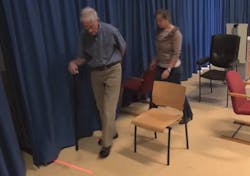Laser guide shoes prevent 'freezing' in Parkinson patients trying to walk (see the videos)
Freezing of gait, an absence of forward progression of the feet despite the intention to walk, is a debilitating symptom of Parkinson's disease. Laser guide shoes developed at the University of Twente (Enschede, Netherlands) and Radboud University Nijmegen Medical Centre (Nijmegen, Netherlands) that project a line on the floor to the rhythm of the footsteps help trigger the Parkinson's patient to walk.1 The shoes benefit the wearer significantly, according to the researchers.
Walking problems are common and very disabling in Parkinson’s disease. In particular, freezing of gait is a severe symptom which generally develops in more advanced stages. It can last seconds to minutes and is generally triggered by the stress of an unfamiliar environment or when medication wears off. Because the foot remains glued to the floor but the upper body continues moving forward, it can cause the person to lose her balance and fall.
Lines on the floor
Parkinson patients experience a unique phenomenon. By consciously looking at objects on the floor, such as the lines from a zebra crossing (visual cues), and stepping over them, they are able to overcome their blockages during walking. This activates other circuits in the brain, releasing the blockages and allowing the person to continue walking. This is why patients often make use of floor tiles at home. With the laser shoes, these useful cues can be continuously applied in everyday life, to walk better and safer. The principle behind the laser shoes is simple: upon foot contact, the left shoe projects a line on the floor in front of the right foot. The patient steps over or towards the line, which activates the laser on the right shoe, and so on.
RELATED: Neuronal targets for optogenetics shown to restore movement in Parkinson's disease model
The present research study shows a beneficial effect in a large group of patients. The number of "freezing" episodes was reduced by 46% with the use of the shoes. The duration of these episodes was also divided by two. Both effects were strongest in patients while they had not taken their medication yet. This is typically when patients experience the most problems with walking. But an improvement was also seen after the patients had been taking their medication.
Video 1: Patient walking with laser shoes switched off. (Radboud UMC)
Video 2: Patient walking again, but now with laser shoes turned on. (Radboud UMC)
"Our tests were administered in a controlled lab setting with and without medication," says researcher Murielle Ferraye, who developed the laser shoes. "Further research in their everyday environment is necessary. We plan on testing this using laser shoes that in the meantime came on the market."
Of the nineteen patients who tested the shoes, the majority would be happy to use them. The patients did not seem to mind that the laser was activated for each single step. "Ideally, the laser should only be activated once the blockage is detected, but we're not quite there yet," says Ferraye. "Freezing is a very complex phenomenon."
Source: https://www.radboudumc.nl/en/news-items/2017/laserschoen-voorkomt-blokkade-bij-parkinson
REFERENCE:
1. Claudia Barthel et al., Neurology (2017); https://doi.org/10.1212/WNL.0000000000004795.

John Wallace | Senior Technical Editor (1998-2022)
John Wallace was with Laser Focus World for nearly 25 years, retiring in late June 2022. He obtained a bachelor's degree in mechanical engineering and physics at Rutgers University and a master's in optical engineering at the University of Rochester. Before becoming an editor, John worked as an engineer at RCA, Exxon, Eastman Kodak, and GCA Corporation.
